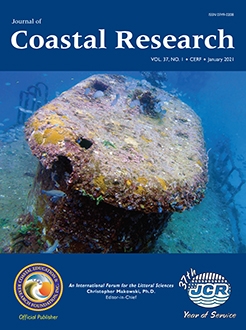Finkl, C.W. and Makowski, C., 2021. Alongshore classification and super domain delineation of coastal belts based on interpretation of biophysical catenary sequences observed from satellite images. Journal of Coastal Research, 37(1), 1–25. Coconut Creek (Florida), ISSN 0749-0208.
The cross-shore classification of coastal belts, facilitated by the interpretation of biophysical features from satellite imagery, is an adjunctory approach to traditional alongshore classification procedures. Methods such as the Biophysical Cross-shore Classification System (BCCS) (Finkl and Makowski, 2020a) and the Coastal Belt Linked Classification (CBLC) (Finkl and Makowski, 2020d) not only provide insight into cross-shore natural ecological variability and zonation, but also emphasize eco-geomorphological linkages so that shore-normal transitions and successions can be delineated and understood. The discernment of numerous cross-shore biophysical transect codifications in a satellite image seascape scene (referred to as either BCCS or CBLC code sequences) results in coastal belt segmenting that identifies offshore, nearshore, inshore, and onshore similarities and differences. This, in turn, can be correlated alongshore by establishing the swath widths of each cross-shore transect as an individual domain. Data integration and interpretation processes are similarly applied as procedural management of geological borehole (well) logs to determine drilling and petrophysical parameters. This study demonstrates that once all individual alongshore domains are interpreted for a specific coastal area, they can be collectively amalgamated and concised to create a universal alongshore super domain for the entire coastal belt. The advantage of constructing a Concised Alongshore Super Domain is that the procedure provides a sagacious and rational basis for swath alongshore classification of coastal belts. This study shows the effective use of this methodology across coastal belts of varying latitudes, as the interpolation of shore-normal ecological sequences validates the cross-shore correlation between transects and can result in a universal alongshore classification process in the form of super domains for coastal belts worldwide.





